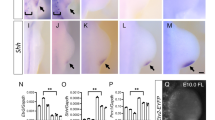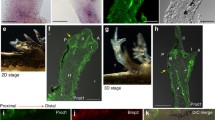Abstract
Polarized expression of the Sonic hedgehog (Shh) gene in the posterior mesenchyme is essential for pattern formation in the appendages of higher vertebrates, from teleost fins to tetrapod limb buds. We report on a sequence in intron 5 of the Lmbr1 gene, which resides approximately 1 Mb from the Shh coding region in the mouse genome and is highly conserved among teleost fishes and throughout the tetrapod lineage. Positional cloning revealed that two mouse mutations, Hx and M100081, characterized by mirror-image digit duplication and ectopic anterior Shh expression, have base substitutions in this sequence. Absence of the conserved sequence in limbless reptiles and amphibians and a cis-trans test using the Hx and Shh KO alleles suggest that the sequence is a cis-acting regulator that controls the polarized expression of Shh.








Similar content being viewed by others
References
L Bejder BK Hall (2002) ArticleTitleLimbs in whales and limbless in other vertebrates: mechanisms of evolutionary and developmental transformation and loss. Evol Dev 4 445–458 Occurrence Handle10.1046/j.1525-142X.2002.02033.x Occurrence Handle12492145
I Blanc A Bach B Robert (2002) ArticleTitleUnusual patter of Sonic hedgegog expression in the polydactylous mouse mutant hemimelic extra-toes. Int J Dev Biol 46 969–974 Occurrence Handle1:CAS:528:DC%2BD38XptlKhs7Y%3D Occurrence Handle12455636
R Carroll (1988) Vertebrate Paleontology and Evolution. Freeman New York
J Charite DG MacFadden EN Olson (2000) ArticleTitleThe bHLH transcription factor dHAND controls Sonic hedgehog expression and establishment of the zone of polarizing activity during limb development. Development 127 2461–2470 Occurrence Handle10804186
JA Clack (2002) Gaining Ground: The Origin and Evolution of Tetrapods. Indiana University Press Bloomington, Ind
RM Clark PC Marker DM Kingsley (2000) ArticleTitleA novel candidate gene for mouse and human preaxial polydactyly with altered expression in limbs of Hemimelic extra-toes mutant mice. Genomics 67 19–27 Occurrence Handle10.1006/geno.2000.6225 Occurrence Handle1:CAS:528:DC%2BD3cXlslylsL8%3D Occurrence Handle10945466
EL Coghill A Hugill N Parkinson D Davison P Glenister et al. (2002) ArticleTitleA gene-driven approach to the identification of ENU mutants in the mouse. Nat Genet 30 255–256 Occurrence Handle10.1038/ng847 Occurrence Handle11850622
MJ Cohn C Tickle (1999) ArticleTitleDevelopmental basis of limblessness and axial patterning in snakes. Nature 399 474–479 Occurrence Handle10.1038/20944 Occurrence Handle1:CAS:528:DyaK1MXjvV2juro%3D Occurrence Handle10365960
F Drossopoulou KE Lewis JJ Sanz-Ezquerro N Nikbakht AP McMahon et al. (2000) ArticleTitleA model for anteroposterior patterning of the vertebrate limb based on sequential long- and short-range Shh signaling anf Bmp signaling. Development 127 1337–1348 Occurrence Handle1:CAS:528:DC%2BD3cXjtFWms7k%3D Occurrence Handle10704381
Y Echelard DJ Epstein B ST-Jacques L Shen J Mohler et al. (1993) ArticleTitleSonic hedgehog, a member of a family of putative signaling molecules, is implicated in the regulation of CNS polarity. Cell 75 1417–1430 Occurrence Handle1:CAS:528:DyaK2cXis1amsrs%3D Occurrence Handle7916661
T Endo H Yokoyama K Tamura H Ide (1997) ArticleTitle Shh expression in developing and regenerating limb buds of Xenopus laevis. Dev Dyn 209 227–232 Occurrence Handle10.1002/(SICI)1097-0177(199706)209:2<227::AID-AJA8>3.0.CO;2-K Occurrence Handle1:CAS:528:DyaK2sXktVCmtrk%3D Occurrence Handle9186057
HC Heus A Hing MJ van Baren M Joose GJ Breedveld et al. (1999) ArticleTitleA physical and transcriptional map of the preaxial polydactyly locus on chromosome 7q36. Genomics 57 342–351 Occurrence Handle10.1006/geno.1999.5796 Occurrence Handle1:CAS:528:DyaK1MXivFOrsbc%3D Occurrence Handle10329000
P Heutink J Zguricas Lv Oosterhout GJ Breedveld L Testers et al. (1994) ArticleTitleThe gene for triphalangeal thumb maps to the subtelomellic region of chromosome 7q. Nat Genet 6 287–292 Occurrence Handle1:CAS:528:DyaK2cXivFWitbk%3D Occurrence Handle8012392
CC Hui AL Joyner (1993) ArticleTitleA mouse model of Greig cephalopolysyndactyly syndrome: the extra-toes J mutation contains an intragenic deletion of the Gli3 gene. Nat Genet 3 241–245 Occurrence Handle1:CAS:528:DyaK3sXitFSktL8%3D Occurrence Handle8387379
P Ianakiev MJ van Baren MJ Daly SP Toledo MG Cavalcanti et al. (2001) ArticleTitleAcheiropodia is caused by a genomic deletion in C7orf2, the human orthologue of the Lmbr1 gene. Am J Hum Genet 68 38–45 Occurrence Handle10.1086/316955 Occurrence Handle1:CAS:528:DC%2BD3MXnt1ehsw%3D%3D Occurrence Handle11090342
RL Johnson CJ Tabin (1997) ArticleTitleMolecular models for vertebrate limb development. Cell 90 979–990 Occurrence Handle1:CAS:528:DyaK2sXmtlOgtrY%3D Occurrence Handle9323126
TB Knudsen DM Kochhar (1981) ArticleTitleThe role of morphogenetic cell death during abnormal limb bud outgrowth in mice heterozygous for the dominant mutation Hemimelic-extra toe (Hm x). J Embryol Exp Morphol 65 IssueIDSuppl 289–307 Occurrence Handle7334311
T Koide K Moriwaki K Uchida A Mita T Sagai et al. (1998) ArticleTitleA new inbred strain JF1 established from Japanese fancy mouse carrying the classic piebald allele. Mamm Genome 9 15–19 Occurrence Handle10.1007/s003359900672 Occurrence Handle1:CAS:528:DyaK1cXmtlSmsg%3D%3D Occurrence Handle9434939
S Krauss JP Concordet PW Ingham (1993) ArticleTitleA functionally conserved homolog of the Drosophila segment polarity gene hedgehog is expressed in tissues with polarizing activity in zebrafish embryos. Cell 75 1431–1444 Occurrence Handle1:CAS:528:DyaK2cXhvVOmsbw%3D Occurrence Handle8269519
LA Lettice T Horikoshi SJ Heaney MJ Baren HC van der Linde et al. (2002) ArticleTitleDisruption of a long-range cis-acting regulator for Shh causes preaxial polydactyly. Proc Natl Acad Sci USA 99 7543–7553 Occurrence Handle10.1073/pnas.112212199
LA Lettice SJ Heaney LA Purdie L Li P De Beer et al. (2003) ArticleTitleA long-range Shh enhancer regulates expression in the developing limb and fin is associated with preaxial polydactyly. Hum Mol Genet 12 1725–1735 Occurrence Handle10.1093/hmg/ddg180 Occurrence Handle1:CAS:528:DC%2BD3sXltFygsrg%3D Occurrence Handle12837695
Y Litingtung RD Dahn Y Li JF Fallon C Chiang (2002) ArticleTitle Shh and Gli3 are dispensable for limb skeleton formation but regulate digit number and identity. Nature 418 979–983 Occurrence Handle10.1038/nature01033 Occurrence Handle12198547
GR Martin M Richman S Reinsert JH Nadeau A Joyner (1990) ArticleTitleMapping of the two mouse engrailed-like genes: close linkage of En-1 to dominant hemimelia (Dh) on chromosome 1 and of En-2 to hemimelic extra-toes (Hx) on chromosome 5. Genomics 6 302–308 Occurrence Handle1:CAS:528:DyaK3cXhtlemtLk%3D Occurrence Handle2307472
H Masuya T Sagai S Wakana K Moriwaki T Shiroishi (1995) ArticleTitleA duplicated zone of polarizing activity in polydactylous mouse mutants. Genes Dev 9 1645–1653 Occurrence Handle1:CAS:528:DyaK2MXntFSrs78%3D Occurrence Handle7628698
H Masuya T Sagai K Moriwaki T Shiroishi (1997) ArticleTitleMultigenic crontrol of the localization of the zone of polarizing activity in limb morphogenesis in the mouse. Dev Biol 182 42–51 Occurrence Handle10.1006/dbio.1996.8457 Occurrence Handle1:CAS:528:DyaK2sXhtF2ru78%3D Occurrence Handle9073443
L Niswander GR Martin (1992) ArticleTitleFgf-4 expression during gastrulation, myogenesis, limb and tooth development in the mouse. Development 114 755–768 Occurrence Handle1:CAS:528:DyaK38Xit1yls7Y%3D Occurrence Handle1618140
S Qu KD Niswander Q Ji R ven der Meer D Keeney MA Magnuson R Wisdom (1997) ArticleTitlePolydactyly and ectopic ZPA formation in Alx-4 mutant mice. Development 124 3999–4008 Occurrence Handle1:CAS:528:DyaK2sXnt12gsL0%3D Occurrence Handle9374397
RD Riddle RL Johnson E Laufer C Tabin (1993) ArticleTitleSonic hedgehog mediates the polarizing activity of ZPA. Cell 75 1401–1416 Occurrence Handle1:CAS:528:DyaK2cXhvVOmsb8%3D Occurrence Handle8269518
H Sasaki (1995) ArticleTitlecDNA selection by in-solution hybridization. Jikken Igaku 13 87–93
JW Saunders MT Gasseling (1968) Ectodermal-mesenchymal interactions in the origin of limb symmetry. R Fleischmajor RE Billingham (Eds) Epithelial-Mesenxhymal Interactions. Williams and Wilkins Baltimore 78–97
J Sharpe L Lettice J Hecksher-Sorensen M Fox R Hill R Krumlauf (1999) ArticleTitleIdentification of sonic hedgehog as a candidate gene responsible for the polydactylous mouse mutant Sasquatch. Curr Biol 9 97–100 Occurrence Handle10.1016/S0960-9822(99)80022-0 Occurrence Handle1:CAS:528:DyaK1MXhtVKjur8%3D Occurrence Handle10021368
M Shimamura H Yasue K Ohshima H Abe H Kato et al. (1997) ArticleTitleMolecular evidence from retroposons that whales form a clade within even-toed ungulates. Nature 388 666–670 Occurrence Handle10.1038/41759 Occurrence Handle1:CAS:528:DyaK2sXlsV2qtbY%3D Occurrence Handle9262399
D Sivastava P Cserjesi EN Olson (1995) ArticleTitleA subclass of bHLH proteins required for cardiac morphogenesis. Science 270 1995–1999 Occurrence Handle1:CAS:528:DyaK28XltlSh Occurrence Handle8533092
CJ Tabin (1992) ArticleTitleWhy we have (only) five fingers per hand: hox genes and the evolution of paired limbs. Development 116 289–296 Occurrence Handle1:CAS:528:DyaK3sXnsFCmsA%3D%3D Occurrence Handle1363084
M Tanaka A Munsterberg WG Anderson AR Prescott N Hazon et al. (2002) ArticleTitleFin development in a cartilaginous fish and the origin of vertebrate limbs. Nature 416 527–531 Occurrence Handle1:CAS:528:DC%2BD38XivVOnsbc%3D Occurrence Handle11932743
P te Welsher M Fernandez-Teran MA Ros R Zeller (2002a) ArticleTitleMutual genetic antagonism involving GLI3 and dHAND prepatterns the vertebrate limb bud mesenchyme prior to SHH signaling. Genes Dev 16 421–426
P te Welscher A Zuniga S Kuijper T Drenth HJ Goedemans et al. (2002b) ArticleTitleProgression of vertebrate limb development through SHH-mediated counteraction of GLI3. Science 298 827–830 Occurrence Handle1:CAS:528:DC%2BD38XotFSntb8%3D
J Thacher (1877) ArticleTitleMedian and paired fins, a contribution to the history of vertebrate limbs. Trans Conn Acad 3 281–310
MA Torok DM Gardner JC Izpisua-Belmonte SV Bryant (1999) ArticleTitleSonic hedgehog (shh) expression in developing and regenerating axolotl limbs. J Exp Zool 284 197–206 Occurrence Handle10.1002/(SICI)1097-010X(19990701)284:2<197::AID-JEZ9>3.3.CO;2-6 Occurrence Handle1:CAS:528:DyaK1MXksVyjsb8%3D Occurrence Handle10404648
O Tsukurov A Boehmer J Flynn JP Nicolai BC Hamel et al. (1994) ArticleTitleA complex bilateral polysyndactyly disease locus maps to chromosome 7q36. Nat Genet 6 282–286 Occurrence Handle8012391
J Wallin J Wilting H Koseki R Fritsch B Christ R Balling (1994) ArticleTitleThe role of Pax-1 in axial skeleton development. Development 120 1109–1121 Occurrence Handle1:CAS:528:DyaK2cXltlSktL0%3D Occurrence Handle8026324
B Wang JF Fallon PA Beachy (2000) ArticleTitleHedgehog-regulated processing of Gli3 produces an anterior/posterior represser gradient in the developing vertebrate limb. Cell 100 423–434 Occurrence Handle1:CAS:528:DC%2BD3cXhsVOltbc%3D Occurrence Handle10693759
DG Wilkinson (1992) In Situ Hybridization: A Practical Approach. Oxford University Press Oxford, UK
Y Yang G Drossopoulou PT Chuang D Duprez E Marti et al. (1997) ArticleTitleRelationship between dose, distance and time in Sonic Hedgehog-mediated regulation of anteroposterior polarity in the chick limb. Development 124 4393–4404 Occurrence Handle1:CAS:528:DyaK2sXnsFWmt7c%3D Occurrence Handle9334287
M Zhu X Yu (2002) ArticleTitleA primitive fish close to the common ancestor of tetrapods and lungfish. Nature 418 767–770 Occurrence Handle10.1038/nature00871 Occurrence Handle1:CAS:528:DC%2BD38XmtV2gu7w%3D Occurrence Handle12181564
Acknowledgements
We are grateful to J. C. I. Belmonte and J. F. Fallon for reading the manuscript and giving useful comments; to H. Yamamoto, K. Tsuchiya, M. Sakaizumi, N. Miyashita, H. Suzuki, A. Watanabe, H. Tamate, M. Taira, Y. Kikkawa for their gifts of valuable materials for phylogenetic analysis; to S. Brown for the gift of YAC clone I116C10; and to P. Beachy for providing Shh knockout mice, A. McMahon for the Shh probe, G. Martin for the Fgf4 probe, C. C. Hui for the Gli3 probe, and M. Scott for the Ptc probe. We thank S. Makino, S. Tanaka, A. Oka, A. Mita, K. Ishihara, S. Sakamoto, N. Saito, and K. Sorimachi for their valuable advice. This study was supported in part by grants-in-aid from the Ministry of Education, Culture, Sports, Science and Technology of Japan. This paper is contribution No. 2489 from the National Institute of Genetics, Japan.
Author information
Authors and Affiliations
Corresponding author
Rights and permissions
About this article
Cite this article
Sagai, T., Masuya, H., Tamura, M. et al. Phylogenetic conservation of a limb-specific, cis-acting regulator of Sonic hedgehog (Shh) . Mamm Genome 15, 23–34 (2004). https://doi.org/10.1007/s00335-033-2317-5
Received:
Accepted:
Issue Date:
DOI: https://doi.org/10.1007/s00335-033-2317-5




